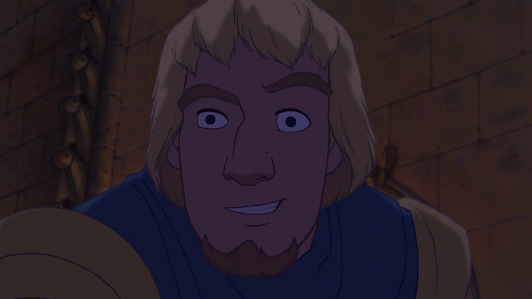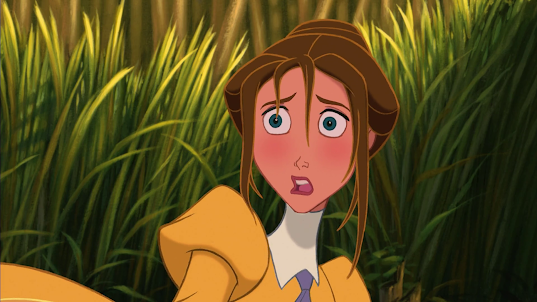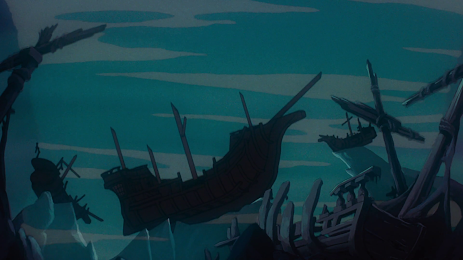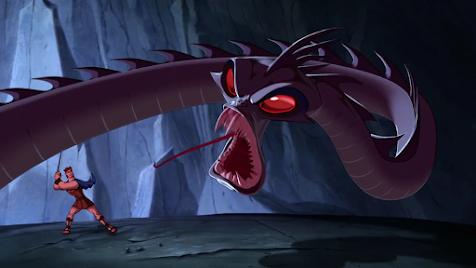One thing that fascinates me about the DISNEY Movies released between 1989 to 2004 is the amount of craft that is done on the Computer when making those 2D Animated films.
I see people on Social Media say they prefer the 2D Animation of DISNEY rather than the CG stuff the MOUSE HOUSE demands today.
But what those people don't know is that the 1989-2004 filmography was actually made using the digital method, even if the machines were proprietary to the Mouse House.
And they were UNIX based machines based on PIXAR's Image Computer from 1986.
The P-II Machine to be exact.
And they can't operate by themselves as you need a host machine from either:
Silicon Graphics, or Sun Microsystems such as the Sun-1 shown below.
Disney using x86/x64 based hardware wouldn't happen until roughly 20 years later when BOB IGER became CEO in 2005 and later mandated TOONBOOM HARMONY.
The CAPS Systems may have been the Pixar Image Computers but like I said, they needed a host terminal to access their full capabilities.
Disney's preferred UNIX Terminals were either
The Sun Microsystems Sun-3,
The Silicon Graphics IRIS 3100 Series,
or the DEC MicroVAX III workstations.
Though behind-the-scenes captures of the workstations for the later films showed that Disney moved on to later SGI Workstations for their animation Desks.
You can't see their Desktop Towers but I have a hunch that by the time POCAHONTAS was nearing the end of production in 1995, the animators started using INDIGO2 Workstations and later the OCTANE and O2 Workstations as well.
We really couldn't grasp the majesty of these how these UBER-EXPENSIVE UNIX based Computers that the Mouse House bought in the late 80s would provide the best of the best of Digital 2D Animation during the 90s but it tells us the Mouse House was ahead of the competition but that's because DISNEY was willing to innovate after ousting Ron Miller and then bringing in...
Michael Eisner, Jeffery Katzenberg, & Frank Wells in 1984.
other studios like...
DON BLUTH,
JUMBO PICTURES,
and a majority of anime studios in Japan
held out and stayed firmly with the photographic Acetate Cel Method probably either due to the high costs for purchasing or building the equipment as well as PHOTOGRAPHY Aesthetics.
The COMPUTER ANIMATION PRODUCTION SYSTEM
aka CAPS
was DISNEY's return to visual greatness that was lost when the company completely switched the inking process to XEROGRAPHY in 1961 with 101 Dalmatians.
For example, when the animation switched to Xerography, the inkers were laid off and in their place were operators who had to grab the cleaned up drawings from the animators, layout the lithograph plates, etc.
Compared to today's viewers who like the Xeroxed look to the animation cels better than the Vector line art of today, the Xerography method had a mixed reputation within DISNEY.
For Example, WALT DISNEY himself hated the Xeroxed look because to him, the cels were too sketchy
and to him, they don't have the fantasy or perfect artistic look that he championed since Snow White in 1937.
Others like animator MILT KAHL however championed the Xeroxed look because now the animators could finally see their drawings literally come to life instead of seeing an ink-traced amalgamation of their art.
"Sacre Bleu!!! I'm sketchy!!!"
To a point where MILT himself was very defensive of his rough sketchy artwork.
Milt Kahl angry at people in the studio who want to water down his rough drawings.
And it clashed with Walt's demands.
According to Andreas Deja on his blog DEJA VIEW, he had an anecdote where Milt said that he wished that Walt would permit the need to replicate the rough drawings but Walt said:
"NO, NO!!! You want that nice, fine line around the characters."
One of the things lost in the Xerography process was Colored outlines.
Click on the image of Wendy and zoom into the fine details to prove once and for all that she has colored outlines on her acetate celluloid.
DISNEY preferred his colored outlines for his 1937-1959 films but until 1977, the limitations of Ink Toner technology precluded the use of Colored Outlines.
So you had to contend with your cels looking like this:
Without Milt Kahl's signature that is....
To the point that in order to achieve that colored outline look again,
You had to ink them yourself once the Xerography process was done...
Some like SPONGEBOB later in 1999 combined both xerox and hand inking.
"And it was only for one Season because starting in Season 2,
all our drawings were scanned into the computer for the Toon Boom Ink and Paint Process. "
while others like Martin Rosen detested xerox and preferred hand inking all the way if the animation cels in WATERSHIP DOWN and THE PLAGUE DOGS are any indication.
The colored outlines on cels in movies released after 1977 however are a lie, at least to my eyes.
I've conflicting statements on how THE RESCUERS brought back some form of Colored Outlines but if you look back at my SEPTEMBER 2023 post on Colored Outlines, I stated that the toners used for THE RESCUERS were really meant to be used for characters like Bernard and Bianca since they're mice.

Other uses of Color Toners in animated films before 1989 are just black outlines with the opacity settings set by the operator so it doesn't really look like colored outlines to me but rather translucent black outlines that let the acrylic paint on the back of the cel dictate that.
CAPS brought that back but in a weird way.
Because of the digital nature of CAPS, I could guess careful attention was made by the Digital Inkers to go into the SCANNED pencil drawings and pinpoint where to separate the part where the line gets colored so it doesn't interfere with the other parts of the pencil drawing.
And despite some featurettes in some Platinum or Diamond Edition DVDs or Blu-Rays saying so otherwise,
The digital cels aren't perfect vector outlines.
It's more noticeable via this screenshot from THE EMPEROR'S NEW GROOVE showing Yzma's teeth.
The outlines are still as rough as the part of the pencil lead that makes contact on the animator's paper.
We often didn't know that due to the low resolution of VHS, Laserdisc, and DVD
but thanks to the High-Def graphical fidelity of Blu-Ray and 4K Streaming, we can see all those colored raster rough Pencil Outlines.
Here are some wonderful examples of Disney Digital Cels with that lovely Rough Pencil that not even a simple paint bucket tool could fix:
(I recommend clicking on the images or download them and then zoom into the fine details.)
My guess is that the artists decided to keep the rough pencil texture on the outlines because it shows that it's actual hand-crafted art that's done physically on paper.
Wacom Tablets were available during the Disney Renaissance but they were just traditional Tablets.
Back in the 90s, Cintiqs didn't exist yet. They wouldn't come out until the 2000s.
Yes, the films were digitally colored but the drawings themselves were originally drawn on paper even during Cleanup and Inbetweening stages before they were scanned into the computer at the highest quality image file imaginable.
You have to remember that the file system Disney used for their digital cels were proprietary to their software, plus it predated standards like JPEG, PNG, etc. by several years.
By the way, these Screenshots above are from my Blu-Ray Collection but converted via VLC Player's convert tool.
One major upgrade that Disney had when they switched from a Rostrum Camera to the computer was the Multiplane Camera.
As I've stated in my past post about the old-school Multiplane Camera,
The Camera does not move.
Only the artwork could move.
The old system limited the multiplane shots to stationary shots, plus the old multiplane camera had reliability problems too.
For example, the lights would go out, the electricity could go out, the artwork could go awry, and yes, even a Camera Negative defect could occur.
The digital Multiplane Camera on the other hand is much more versatile than the old school camera.
Not only could you do your classic Multiplane sequences like you could far more often than in the old method which could only be through select scenes but you can actually move the camera in a Z-Axis.
Granted, it used a primitive form of a 3D Camera where movement was dictated through a command-line interface instead of a GUI despite using a GUI-based Computer environment.
Or I don't know in full since the featurettes aren't always that elaborate about how the system does it's works.
So yeah, it's early form of a CGI Camera but the only assets that are 3D that's not an object like Mcleach's bushwhacker truck are the flat artwork that zip past the camera.
Such as this opening shot from THE RESCUERS DOWN UNDER in 1990.
But considering the
NOW slow nature of these original machines CPUs and chipsets,
these multiplane sequences can be quite taxing on the hardware of the time period,
especially if 400+ layers of artwork are used.
For example, this opening cloud scene from HUNCHBACK almost killed the CAPS' CPUs.
Don Hahn admitted so in the Commentary for HUNCHBACK.
To quote Don Hahn:
"We were told the computers could not crash, that they could hold so much information,
And we crashed them twice, and we're damn proud of it."
Whenever the animators create them Colored Model Sheets, they for some reason use a grey backdrop.
How quant but at the same time, serene, even for the 90s.
I know that what I'm going to say is gonna by somewhat controversial considering the comments I'm seeing posted on Social Media from Animation fans but.....
DISNEY, even back in the late 80s and beyond were starting to go all in on CGI but back in the day, they limited the CG to shots that the multiplane camera could not do.
While in films like MOUSE DETECTIVE, OLIVER & COMPANY, and LITTLE MERMAID, they limited the CGI to wireframe models that were printed on paper via an HP Line Plotter before they were xerox into animation cels,
Which therefore were limited to things like....
Vehicles
And Camera Tracking shots such as the famous BIG BEN Sequence:
As well as the staircase for Ariel to run downwards
CAPS allowed better integration of the two mediums together thanks to the all digital nature of the 2D artwork, the Z-Axis Camera, and the CG Polygons.
Though early on, Disney wisely stuck to cel shading for the models if Mcleach's Bushwhacker truck is any indication.
Because according to how the rendering was for things like the Sydney Opera House,
the early rendering system admittingly did not age well at first.
Seriously, this Opera House render did not age well when compared to how much better the Ballroom from BEAUTY AND THE BEAST looks as shown below:
And yes, I do have an image of the Bushwhacker as it appeared on the CAPS Paint Program UI
Disney however didn't use 3DCG all the time though.
Like with the OLDER Multiplane Camera from 1937-1989, the Studio Wisely limited CG to things that are only necessary that could not be done efficiently or practically.
And they also experimented with other things too.
Aladdin used Texture Mapping for the MAGIC CARPET's Pattern
The Carpet is still hand drawn but 2D CG tools were used to apply the pattern on the Carpet.
Here's the pattern that's used for the Carpet before Texture Mapping:
Lion King would use automation for CG Crowds during the Wildebeest Stampede scene.
"Still better Crowd automated simulation than the MASSIVE software's
Crowd Simulation used in Live Action Movies these days."
I can't find for the life of me anything innovative for the CG in Pocahontas but don't say the texture mapping for GRANDMOTHER WILLOW counts as that is just the same tech used for the magic carpet in Aladdin.
"My bark is still worse than that Carpet's bite!!!"
Hunchback had some 3D camera tracking shots
as well as used some Crowd Simulation for some of the Crowd shots in that film.
The Crowd standing in front of the little girl are cel shaded crowds.
Hercules used digital morphing for the 2D Assets if the Cloud Formations are an indication.
as well as the uber-famous CG Hydra and it's many heads in Hercules
Mulan decided to introduce a new take on the classic Multiplane Camera which they called Faux-plane.
This might look like an Old-School Multiplane shot done on the Computer using that Z-Axis Camera but pay attention to the each of the top sections of each watch tower on the Great Wall of China.
Notice that they pass through sort of in Parallax.
Basically the elements are split and merged together like a paper cutout but in the digital method.
Sort of like a CG model but using flat 2D artwork pieced together carefully.
But that technique didn't last because by the time TARZAN came, the animators switched to Full CG background polygons for certain backgrounds but to keep the BGs painterly, the wrote a piece of software called DEEP CANVAS.
Deep Canvas was a tool that took the CG models, and then the artist with their Wacom Tablet, goes into the model and paints strokes based on various shades to give the object a very painterly look.
The CG Polygons are then set to Hidden but the painted Texture remains.
Such as this scene from SON OF MAN which actually was used by an animator to demonstrate how
the Deep Canvas process works step by step.
By the time the 2000s came around, all the other competing studios were finally convinced to switch to Digital Ink and Paint
But not for long due to the ALL-CGI mandate for Theatrical Animation,
It also became clear that the systems that Disney used were starting to show their age by the beginning of the new millennium.
While that system still gave way for all-time 2000s classics like...
The Emperor's New Groove in 2000,
Atlantis: The Lost Empire in 2001,
LILO AND STITCH in 2002,
Treasure Planet, Also from 2002,
By then, the industry had changed.
Studio executives in America developed an apathy towards 2D Animation.
in favor of All-CGI,
"NO IFS AND OR BUTS!!!"
Blame it all on Executives demanding more from BOX OFFICE draws than with Critical Acclaim from Critics.
And studios that were now sold on DIGITAL INK AND PAINT and committed to staying with the 2D medium preferred off-the-shelf software like TOONBOOM instead of something proprietary like Disney's CAPS system.
And yes, that even includes those INFAMOUS Direct-to-Video sequels since they don't even use CAPS but instead use TOONBOOM for their animation since they're animated at separate facilities.
After the failure of HOME ON THE RANGE in 2004,
THE CAPS Systems were all dismantled.
Leaving only one Computer left but that's only for reading and fetching the data for these older movies so they can be used for DVD, Blu-Ray, UltraHD Blu-ray, and 4K Streaming releases.
....
I don't know if the Disney Engineers have switched the last remaining CAPS Computer's storage to Solid State but considering the nature of Archival storage, I can only imagine the maintenance required to preserve all those 1989-2004 Classics under one Computer.
I know it's highly unlikely I'll ever come across one in Thrift Stores or eBay but just this one, I would like to get my hands on one of the original computers Disney used throughout the 90s for their movies and experience their tech myself.
Because emulating their original hardware even with the best Linux distros out there is probably not going to be feasible due to the proprietary nature of the code.
Oh and by the way, not everything Disney used in their 90s computers were all proprietary.
For things like CGI,
they used Alias Poweranimator, Softimage3D, and later Autodesk Maya.
As for final film editorial, we all know it's going to be AVID MEDIA COMPOSER.
Oh the memories of these Proprietary UNIX Computers.
Nowadays, everything is produced on these modern x64-based machines
like AMD's THREADRIPPERS for example.











































































































